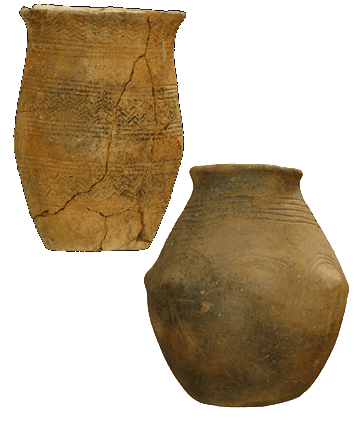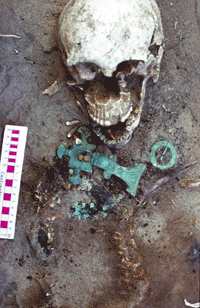2000 days of digging
LRC Project EH3516 in association with the Malton Museum Foundation funded By English Heritage From the Aggregates Levy Sustainability Fund
Early Bronze Age Beaker and Anglo-Saxon Buckleurne on exhibition for the first time in an exhibition celebrating 25 years of discovery on the sands and gravels of the Vale of Pickering. The discovery of an Early Anglo-Saxon  cemetery at Cook's Quarry, West Heslerton, in 1977, led to the development of one of the longest running archaeological projects in Britain. Excavations at the quarry from 1977 to 1985 funded from the national Rescue Archaeology programme revealed an unanticipated wealth of activity spanning the period from the Late Mesolithic to Mediaeval. The archaeological deposits identified at the quarry were exceptionally well preserved, by a sealing layer of blown sand that had built up over 7000 years. The evidence from the quarry highlighted the the difficulty of seeing and assessing archaeological deposits beneath windblown sands. Heslerton has been the setting for a range of different interlinked projects designed to identify this buried resource and it was only fitting that the results of these projects be presented at a local venue in this ALSF funded exhibition. cemetery at Cook's Quarry, West Heslerton, in 1977, led to the development of one of the longest running archaeological projects in Britain. Excavations at the quarry from 1977 to 1985 funded from the national Rescue Archaeology programme revealed an unanticipated wealth of activity spanning the period from the Late Mesolithic to Mediaeval. The archaeological deposits identified at the quarry were exceptionally well preserved, by a sealing layer of blown sand that had built up over 7000 years. The evidence from the quarry highlighted the the difficulty of seeing and assessing archaeological deposits beneath windblown sands. Heslerton has been the setting for a range of different interlinked projects designed to identify this buried resource and it was only fitting that the results of these projects be presented at a local venue in this ALSF funded exhibition.
The exhibition and accompanying booklet "25 years of archaeological research on the sands and gravels of Heslerton" have been very well received. Visitor figures were increased by nearly 50% during the year and school visits have continued during the winter. Refurbishing of the gallery in the Museum and the provision of a stair lift for the disabled, turned a dowdy gallery into a bright and accessible place. The exhibition is to be extended into a second year with new information gathered as part of Project 3409. This collaboration between the Malton Museum Foundation and the Landscape Research Centre has been a significant outreach project and showplace for the results of this major surveys.
 This has been a local exhibition, although it was featured in the national press and had many visitors from around the country and abroad; its importance is that it has been available for local people, many of whose homes have been built using the building sand that lies beneath the archaeology of Heslerton. It has been most gratifying to realise, both from comments in the street and from the museum visitors book, that most of the populations of the two Heslertons, East and West, have visited and enjoyed the exhibition. This has been a local exhibition, although it was featured in the national press and had many visitors from around the country and abroad; its importance is that it has been available for local people, many of whose homes have been built using the building sand that lies beneath the archaeology of Heslerton. It has been most gratifying to realise, both from comments in the street and from the museum visitors book, that most of the populations of the two Heslertons, East and West, have visited and enjoyed the exhibition.
Special openings have been held for teachers and local farmers. The displays, which are laid out in chronological order, are supported by reconstruction drawings and information panels which explain the nature of the blown sands and the methods by which the archaeologists are attempting to gather data which will help prevent the accidental discovery or destruction of significant sites in the future.
The exhibition was extended during 2004/5 and finally dismantled in 2005.
An additional permanent exhibition for schools concerned with discovery and the nature of archaeological fieldwork supported by audio-visual materials was prepared and installed in the Museum in 2005.
Click here for the text of the booklet that accompanied the exhibition.
|
